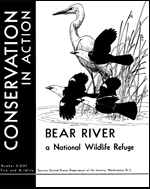United States Fish and Wildlife Service

United States Fish and Wildlife Service: Publications
Date of this Version
1965
Abstract
Myxosoma cartilaginis n. sp. is described from the cartilage of Lepomis macrochirus (bluegill), L. cyanellus (green sunfish) and Micropterus salmoides (largemouth black bass). The development of the parasite is described from naturally infected fish which were held in spore-free water after infection. The sporoplasm invades cartilage, and becomes a multinucleate trophozoite which forms pansporoblasts, each of which produces 2 to 4 spores. The first spores appear in 7 weeks.
The histopathology in the above fish consists at first of little cellular reaction, but after 4 to 5 months epithelioid granulomas appear arround some of the spore masses. Cartilage liquefaction is present around the parasites for at least 5 weeks. Eosinophilic globules are present in cartilage cells adjacent to the lesions. Diffuse infiltration of the spores from the lesions is described.
Of 24 chemicals tested for polar filament extrusion, potasium hydroxide gave the best results.
An illustrated synopsis of the Myxosoma of North American fishes is given. Included is some additional information and illustrarions of M. hoffmani Meglitsch, 1963. Also included is a table showing the hosts, site of infection, geographic location, spore and polare capsule sizes.


Comments
Published in J. Protozool., 12(3), 319-332 (1965).